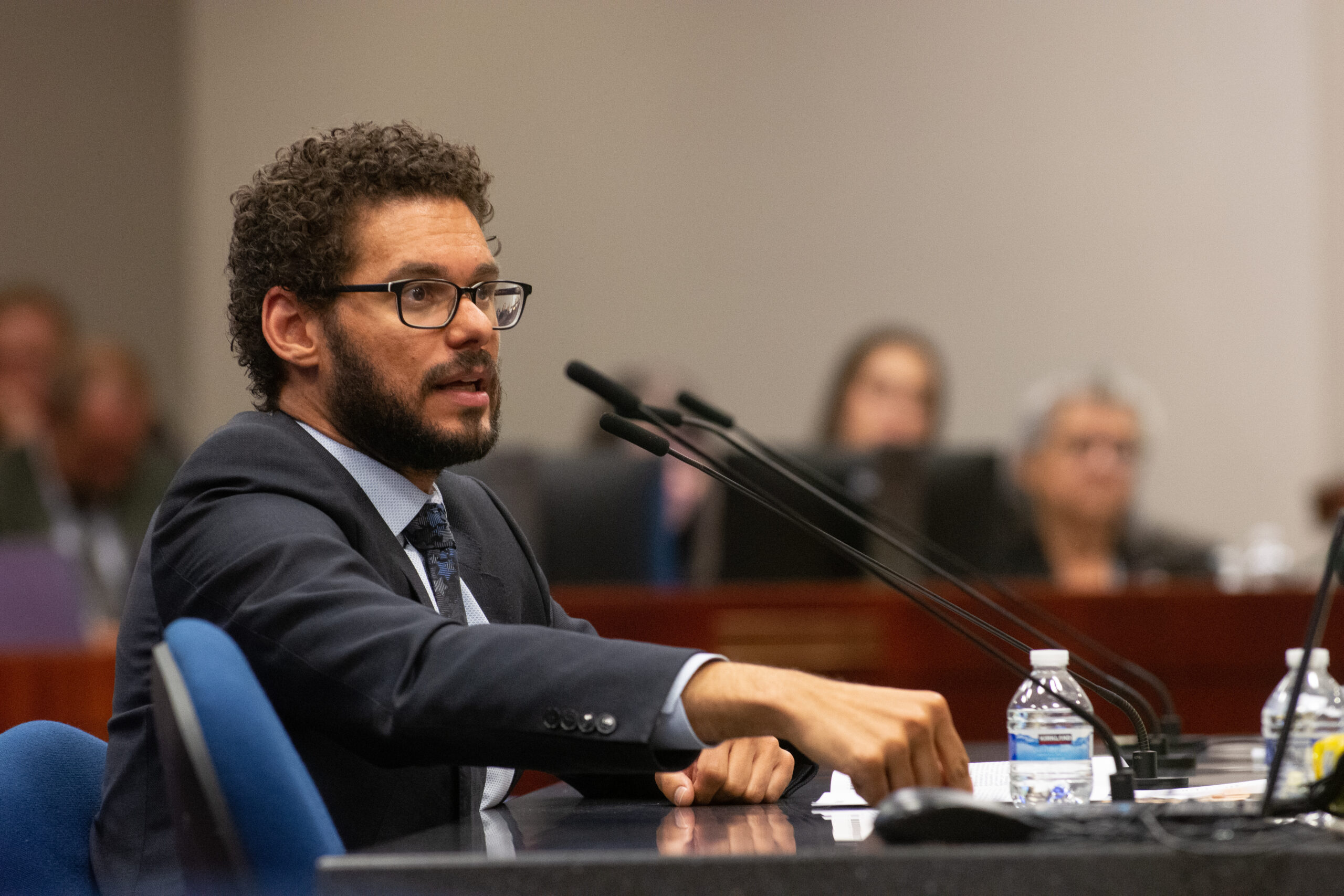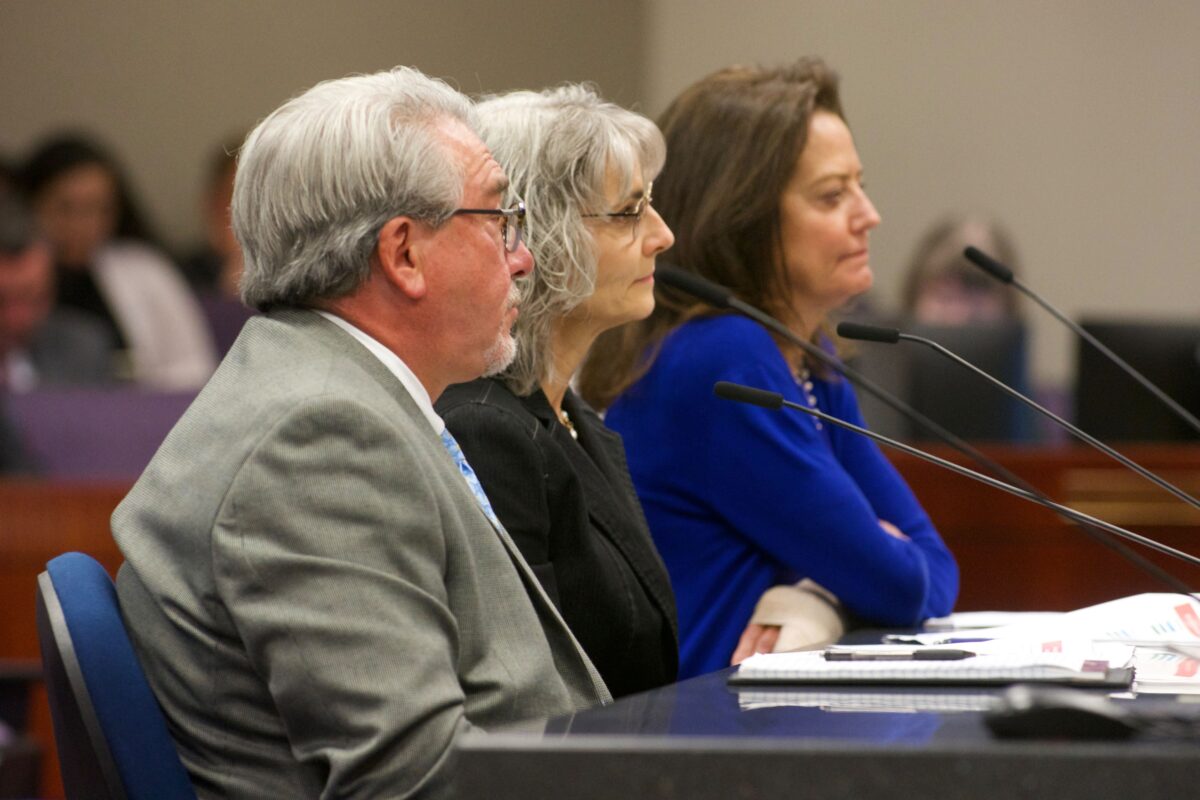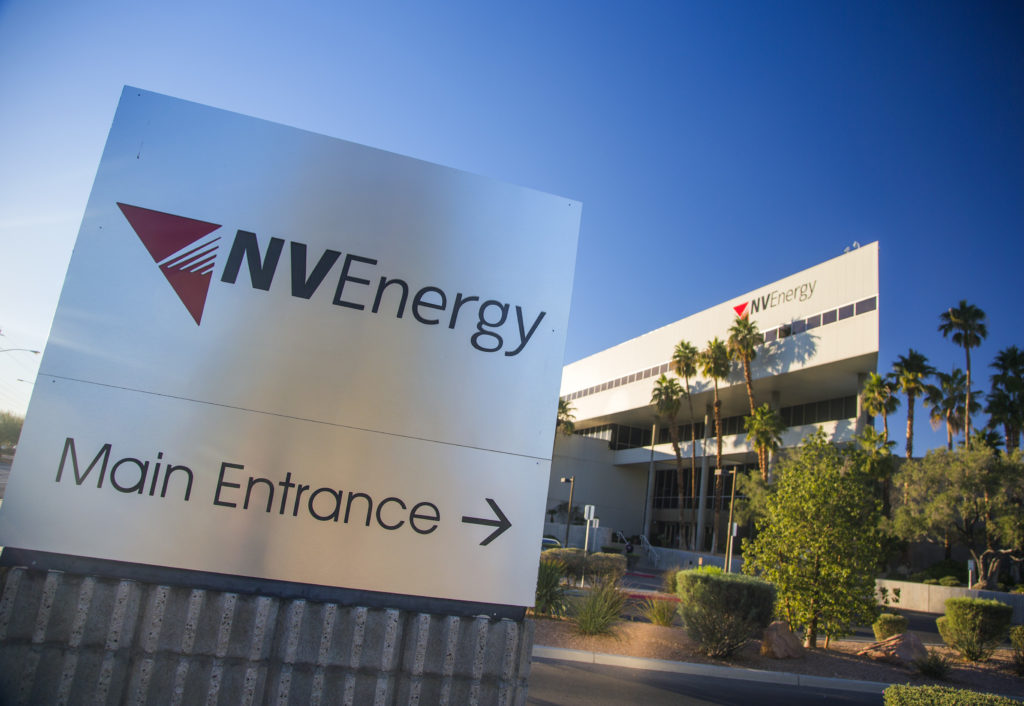Lawmakers weigh more rigorous regulatory planning for NV Energy, Southwest Gas

With less than one week until the end of the 2023 legislative session, lawmakers heard two bills on Tuesday that would bring more scrutiny to each of the state’s largest utilities’ — NV Energy and Southwest Gas — long-term resource planning, while also weighing the need to expand Nevada’s ability to produce energy within its own borders and become less dependent on an increasingly unreliable Western energy market.
That push also comes as rate hikes from both companies — driven in part by volatile natural gas prices and for NV Energy, a need to purchase power on the open market to help meet elevated summer demand — have resulted in significantly higher bills and drawn the ire of Nevada customers looking for more stability in the costs of powering their homes.
Amid the vexation over increasing rates, the electric utility is seeking additional renewable energy-generating resources to meet the state’s increasing Renewable Portfolio Standard. By 2030, 50 percent of electricity sales in the state must come from renewable sources.
But the two utilities are notably split in their approach to the respective utility regulation measures. Southwest Gas is backing an effort (SB281) that would require the utility conduct a resource planning process every three years — similar to the planning process already mandated for NV Energy — designed to meet existing and future demands for natural gas use. This is known as an Integrated Resource Plan, and it is reviewed and approved by state regulators on the Public Utilities Commission of Nevada (PUCN).
Meanwhile, NV Energy is opposed to a bill (AB524) encouraging development of more in-state energy-generating resources through changes to the resource planning process. Company officials argue the bill does not go far enough to reduce the state’s reliance on out-of-state energy purchases, as NV Energy seeks to take advantage of what utility executive Tony Sanchez described as “transformational” opportunities in the form of major federal tax credits available for renewable energy projects through the Inflation Reduction Act (IRA).
“The harm that we feel is going to be coming as a result of a bill that doesn't go far enough in a time of extreme Western energy emergencies, and the time to act [is] today,” Sanchez said during the hearing. “We would prefer a very strong pronouncement and mandate that the state and the utility commission work with all parties, through the full supervision, through the integrated resource planning process at the commission, and work to close that open position as quickly as possible and wean ourselves off of a lot of problems that have been caused by our neighbor to the West.”
The bill, which was introduced last week with roughly 10 days left in the session, marks the culmination of months of negotiations between NV Energy, conservation groups, consumer advocates, large energy customers and the bill’s sponsor, Assemblyman Howard Watts (D-Las Vegas). It proposes allowing NV Energy to submit Integrated Resource Plans more frequently than once every three years and requiring regulators to adopt rules governing amendments to that plan — changes Watts framed as “a balanced policy that moves our state forward and is rooted in improvements to our energy planning process.”
Fueled by concerns over energy reliability and affordability, it would also establish a legislative declaration in support of more dedicated in-state resources and reduced reliance on the regional market — aligning with the energy-focused executive order Gov. Joe Lombardo issued in March. And the bill would require NV Energy to include as part of its resource plan a scenario for closing its open position — the gap between the utility’s owned or leased power generating capacity and anticipated demand — with details on the development of in-state energy resources constructed for that purpose and an evaluation of how those resources will help reduce reliance on market purchases.
Another way of closing that open position would be through a dedicated build-out of transmission — referring to access to energy resources in other states, such as hydropower in the Pacific Northwest, that cannot be curtailed even during times of peak demand.
Despite arguments from NV Energy that those provisions do not go far enough to close the company’s open market position — its reliance on purchasing up to 30 percent of its supply from the regional market to meet peak demand during sweltering summer months — PUCN general counsel Garrett Weir said he believes the bill would “provide direction that emphasizes the need for the plan to demonstrate reduced reliance on market purchases.”
“That would assist the commission in prioritizing that information and making sure to consider it without predetermining the outcome because, again, there could be many ways to get to reliable, affordable service,” he said. “It may not just be the plan that the utility puts forward.”
Rather, NV Energy is seeking a stronger legislative mandate and a message from the Legislature to state regulators to make it clear that closing that open market position is a priority. Sanchez said that could even include raising the Renewable Portfolio Standard to require an even greater percentage of electricity sales to come from renewable energy.

Higher renewable standards would likely give NV Energy greater latitude to pursue development of new in-state renewable energy projects, from solar farms to battery storage, thereby allowing it to pursue federal tax credits through the IRA. Despite the costs of development — which are passed to customers — more in-state resources would mean less reliance on volatile energy prices from the open market.
Building out supply generation is also key for the company to meet the requirements to join a regional transmission organization (RTO) by 2030. An RTO works to facilitate the sharing of resources — power markets and transmission — across geographical areas, typically across multiple states.
However, Watts dismissed the idea of placing specific mandates on PUCN, instead arguing that those decisions should be left up to the commission, “which is designated as the regulator for our public utilities to gather the voluminous information that is at a level of depth far beyond us, as a Legislature, frankly, and to hear from other experts in this arena.”
AB524 received its first hearing Tuesday in a rare joint committee meeting, a move typically reserved for high-profile legislation and major end-of-session bills.
As for the natural gas planning effort, SB281 passed 20-0 out of the Senate on Friday (Sen. Scott Hammond (R-Las Vegas) was absent from the vote) and received its first hearing in its second house Tuesday, drawing support from Southwest Gas and several environmental groups.
“We're trying to create a comprehensive, holistic planning process for the gas utilities, similar to the process that we have for electric utilities,” Watts said during that bill’s hearing.
The proposed changes to resource planning would also expand the PUCN’s responsibilities and oversight, as regulators must balance the interests of ratepayers and company shareholders by ensuring that the utilities’ plans come at the lowest cost to customers and the utility.

Promoting in-state resource generation for NV Energy
Watts described the “overall thrust” behind AB524 as “strengthening planning,” arguing that the proposed changes to resource planning would help the state reduce its reliance on costly energy from the open market and meet ever-increasing energy demand.
“What we want is to have public policy that ensures that we are addressing issues of reliability, that we're addressing issues of affordability and that we are continuing to develop clean energy resources, but that we also make sure that that is vetted through our regulatory system,” he said.
Despite being broadly aligned on their goals — including increasing renewable energy resources, reducing market exposure and making energy more reliable and affordable — Watts and NV Energy ended up on opposite sides of the legislation.
Watts said his bill “is not — as some of these policies that come forward toward the end are — a large, bold policy, in my opinion.” Some of the state’s highest-profile energy policies focused on building out transmission, including SB448, which was introduced in the final weeks of the last session.
In contrast to Watts, Janet Wells, vice president of regulatory affairs at NV Energy, said, “Nevada needs a bold policy directive” to ramp up in-state generation resources and take advantage of federal tax credits.
Though NV Energy was involved in months of negotiations on the bill, company executives still testified in opposition and highlighted what they called an urgent need to expand in-state generating resources.
The electric utility currently owns or controls 6,100 megawatts of generation, but in recent summers demand had peaked at around 9,000 megawatts, requiring NV Energy to meet that demand through expensive market purchases. Wells said the company can produce a megawatt of energy for about $50, while purchasing the same amount of energy from the open market costs more than $150 in the summer of 2021 and more than $230 in the summer of 2022.
Company officials were also critical of California, by far the largest market in the West, and a state that, unlike Nevada, has seen rolling blackouts in recent summers as its energy supply has failed to meet demand. While NV Energy has struggled to meet demand in recent summers and been forced to ask customers to conserve energy, it has not had to rely on rolling blackouts or suffered sweeping grid failures, like Texas saw in 2021 amid extreme winter weather.
Still, in response to a report from the international regulator North American Electric Reliability Corp. that found Nevada among states at risk of an energy resource shortfall through 2027, Weir said he believes Nevada is “relatively well positioned compared to the rest of the country … especially compared to prior summers.”
With neighboring states such as California also heavily relying on the regional market, prices have been driven up. Wells said at peak demand, NV Energy paid as much as $1,800 for a single megawatt hour of power on the open market. The high costs have resulted in NV Energy spending more than $1 billion on open-market energy purchases across 2021 and 2022 to meet extreme demand, with those costs now fueling higher energy bills.
Without a stronger push for closing the open-market position, NV Energy officials said the bill would not do enough to insulate Nevada from future problems afflicting the regional market and the majority of what’s contained in the bill can already be done through the existing regulatory process.
To that point, Weir said the utility is already able to put forward proposals seeking a higher Renewable Portfolio Standard — as it already has, achieving a 37 percent standard in 2022, above the required 29 percent. He acknowledged that any plans put forward by the utility would be evaluated against other proposals for cost effectiveness. Earlier this month, the commission rejected a proposal from the company to replace its final coal-powered plant with a $466 million battery storage system.
Since the IRA’s passage in 2022, NV Energy has been looking to take advantage of an unprecedented suite of tax credits for renewable energy projects that the company argues could in the long run bring down prices by the end of the decade through shaving off development costs.
“If there were a mandate, like increasing the [Renewable Portfolio Standard], if that were added to this bill, that would be the component that would require us to go ahead and close that open position,” Sanchez said. “And that would be palatable with us, and we think would go a long way to protecting Nevadans both from a price standpoint, but from a reliability standpoint, and help us as we continue to decarbonize our system.”

Even as NV Energy officials raised the alarm about the need for stronger language in the bill, Weir said the PUCN hasn’t heard those demand-side concerns.
“There has been no evidence presented to the commission that we should be worried about the sufficiency of the plan that we've approved,” Weir said.
Watts also highlighted the need for changes amid “extremely hot” summers that have increased demand, alongside supply constraints that have similarly been affected by heat waves and drought that have reduced regional hydropower production.
Alongside Watts, representatives of environmental groups criticized the Integrated Resource Plan (IRP) amendment process that has allowed NV Energy to make changes to its three-year resource plan without going through the standard process. Christi Cabrera-Georgeson, deputy director at the Nevada Conservation League, pointed to NV Energy receiving approval from the PUCN for a gas-powered peaker plant (meant to only run during periods of high demand) that was approved via an amendment to the utility’s 2021 Integrated Resource Plan.
“Despite Nevadans being hit hard with high utility bills due to volatile gas prices, this new fossil fuel infrastructure was approved largely due to a broken and outdated IRP process,” she said.
The bill would direct the PUCN to adopt requirements governing the resource planning amendment process, and aims to bring more public input by requiring NV Energy to schedule at least one consumer review session before any resource plan or amendment is filed.
Environmental groups including Western Resource Advocates and the Nevada Conservation League testified in support of the bill Tuesday, alongside the Nevada Resorts Association and major gaming companies, including MGM Resorts and Caesars — large energy customers that have feuded with NV Energy in the past.
“This bill will ensure a transparent process at the PUCN that will fully vet … cost impacts to customers. The bill will ensure that there are in-state resources to support supply and reliability for Nevada's future, and a process that is transparent and fair to customers,” Nevada Resort Association President Virgina Valentine said.
But alongside NV Energy, the bill faced opposition from several labor groups including local unions of the International Brotherhood of Electrical Workers and the Culinary Union. Several union representatives raised similar concerns to NV Energy about the build out of supply, and said opting to increase renewable standards could drive building renewable energy projects.
Watts cautioned against putting too many specific demands into legislation for a process overseen by trained state regulators, which he argued could result in picking “a landing point that might be off the mark in some way.”
“But I do feel that this will help give clear guidance to everyone to move in that direction and to do so as soon as possible,” Watts said, adding that NV Energy’s next Integrated Resource Plan would be submitted in 2024.
Ernest Figueroa, the state’s consumer advocate and a chief deputy attorney general, described a legislative mandate on the PUCN as “akin to putting the thumbs on one scale, the scales of justice, tying the hands of the commission and tying my hands preventing me from making arguments to protect the ratepayers at the commission.”
Several lawmakers on the committee also highlighted complaints from their constituents about continuously increasing energy bills and questioned whether the proposals in AB524 would be enough to lower costs in the short term.
But Watts described the intention behind the bill as a long-range approach, one meant to ensure more stability in the market. He argued that approving too many projects at once would lead to higher costs passed down onto the consumer.
But even that argument was countered by NV Energy, with the company arguing for the urgency to take advantage of IRA funds that will eventually reduce the costs passed down to ratepayers for development of renewable energy projects.
With the two sides apart, lawmakers will have just six days to move the bill out of committee and through both houses before the legislative session ends June 5.
Regulated resource planning for Southwest Gas
Sen. Rochelle Nguyen (D-Las Vegas), who sponsored SB281, a bill that would require triennial resource planning for Southwest Gas, said Tuesday the measure stemmed in part from the PUCN opening “an investigatory docket that evaluated the future of natural gas in Nevada.”
“As a part of that process, many different stakeholders asked for natural gas utilities to be subject to the same type of planning process that the electric utilities undertake,” she said.
She argued the bill would bring greater transparency to Southwest Gas’s utility planning by establishing a process for regulators and ratepayers to weigh in on the company’s plans while also allowing regulators and the utility to address concerns she’s heard from constituents about increasing rates.
The bill would bar Southwest Gas from filing a general rate application — a request to the PUCN to change its rate structure — within 180 days before or after filing of its triennial resource plan.

Scott Leedom, director of public affairs at Southwest Gas, testified in support of the changes to process, which he said would allow regulators to “consider and scrutinize our proposed investments prior to us making them rather than the current process where they review them after they're made during a general rate case proceeding.”
The bill also received support from builders and environmental groups that framed natural gas supply planning as a step toward meeting the state’s emission reduction goals.
The push to require this type of planning for Southwest Gas also follows a failed effort in 2021 led by Assemblywoman Lesley Cohen (D-Las Vegas). Cohen pursued a more prescriptive bill that would have more strictly tied those integrated resource plans to the state’s climate goals — including a push to reduce statewide greenhouse gas emissions to zero or near-zero by 2050.
But amid strong opposition from Southwest Gas — which later supported Cohen’s primary challenger with maximum contributions to his campaign — the bill failed last session.
This year, with Southwest Gas in support, SB281 has moved through the Legislature with bipartisan support. Lawmakers on the committee voted SB281 out of committee immediately after hearing it Tuesday, sending it to the Assembly floor, before it is expected to go to the governor’s desk.
